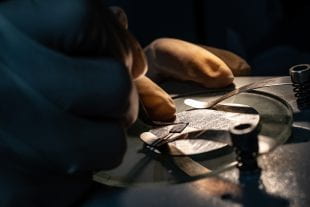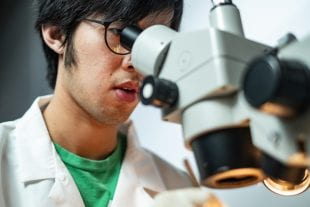David Ruth
713-348-6327
david@rice.edu
Jade Boyd
713-348-6778
jadeboyd@rice.edu
Superconductor’s magnetic persona unmasked
Iron selenide revealed as ‘garden-variety iron-based superconductor’
HOUSTON — (May 20, 2019) — In the pantheon of unconventional superconductors, iron selenide is a rock star. But new experiments by U.S., Chinese and European physicists have found the material’s magnetic persona to be unexpectedly mundane.

Rice University physicists Pengcheng Dai (left) and Tong Chen conducted neutron scattering experiments with colleagues from the U.S., China and Europe and found that magnetic correlations associated with superconductivity in iron selenide are highly anisotropic, just as they are in other iron-based superconductors. (Photo by Jeff Fitlow/Rice University)
Rice University physicist Pengcheng Dai, corresponding author of a study of the results published online this week in Nature Materials, offered this bottom-line assessment of iron selenide: “It’s a garden-variety iron-based superconductor. The fundamental physics of superconductivity are similar to what we find in all the other iron-based superconductors.”
That conclusion is based on data from neutron scattering experiments performed over the past year in the U.S., Germany and the United Kingdom. The experiments produced the first measurements of the dynamic magnetic properties of iron selenide crystals that had undergone a characteristic structural shift that occurs as the material is cooled but before it is cooled to the point of superconductivity.
“Iron selenide is completely different from all the other iron-based superconductors in several ways,” said Dai, a professor of physics and astronomy at Rice and a member of Rice’s Center for Quantum Materials (RCQM). “It has the simplest structure, being composed of only two elements. All the others have at least three elements and much more complicated structure. Iron selenide is also the only one that has no magnetic order and no parent compound.”
Dozens of iron-based superconductors have been discovered since 2008. In each, the iron atoms form a 2D sheet that’s sandwiched between top and bottom sheets made up of other elements. In the case of iron selenide, the top and bottom sheets are pure selenium, but in other materials these sheets are made of two or more elements. In iron selenide and other iron-based superconductors, iron atoms in the central 2D sheet are spaced in checkerboard fashion, exactly the same distance from one another in both the left-right direction and forward-back directions.

Tong Chen, a Rice PhD student “detwinned” iron selenide crystals by gluing them atop much larger crystals of barium iron arsenide. Using a 2014 method developed at Rice, the larger crystals are placed under pressure and detwinned, causing the smaller iron selenide crystals to also snap into alignment. (Photo by Jeff Fitlow/Rice University)
As the materials cool, they undergo a slight structural shift. Instead of exact squares, the iron atoms form oblong rhombuses. These are like baseball diamonds, where the distance between home plate and second base is shorter than the distance between first and third base. And this change between iron atoms causes the iron-based superconductors to exhibit directionally-dependent behavior, like increased electrical resistance or conductivity only in the direction of home-to-second or first-to-third.
Physicists refer to this directionally dependent behavior as anisotropy or nematicity, and while structural nematicity is known to occur in iron selenide, Dai said it has been impossible to measure the exact electronic and magnetic order of the material because of a property known as twinning. Twinning occurs when layers of randomly oriented 2D crystals are stacked. Imagine 100 baseball diamonds stacked one atop the other, with the line between home plate and second base varying randomly for each.
“Even if there is directionally dependent electronic order in a twinned sample, you cannot measure it because those differences average out and you wind up measuring a net effect of zero,” Dai said. “We had to detwin samples of iron selenide to see if there was nematic electronic order.”
Study lead author Tong Chen, a third-year PhD student in Dai’s research group, solved the twinning problem by cleverly piggybacking on a 2014 study in which Dai and colleagues applied pressure to detwin crystals of barium iron arsenide. It was impossible to apply the same method to iron selenide because the crystals were 100 times smaller, so Chen glued the smaller crystals atop the larger ones, reasoning that the pressure needed to align the larger sample would also cause the layers of iron selenide to snap into alignment.

Graduate student Tong Chen spent weeks creating samples to test in neutron scattering beams. About 20 to 30 1-millimeter squares of iron selenide had to be aligned and glued in place atop each crystal of barium iron arsenide. (Photo by Jeff Fitlow/Rice University)
Chen spent weeks creating several samples to test in neutron scattering beams. About 20 to 30 1-millimeter squares of iron selenide had to be aligned and placed atop each crystal of barium iron arsenide. And applying each of the tiny squares was painstaking work that involved a microscope, tweezers and special, hydrogen-free glue that cost almost $1,000 per ounce.
The work paid off when Chen tested the samples and found the iron selenide was detwinned. Those tests with neutron scattering beams at Oak Ridge National Laboratory, the National Institute of Standards and Technology, the Technical University of Munich and U.K.’s Rutherford-Appleton Laboratory also showed iron selenide’s electronic behavior is very similar to that of other iron superconductors.
“The key conclusion is that the magnetic correlations that are associated with superconductivity in iron selenide are highly anisotropic, just as they are in other iron superconductors,” Dai said. “That has been a very controversial point, because iron selenide, unlike all other iron-based superconductors, does not have a parent compound that exhibits antiferromagnetic order, which has led some to suggest that superconductivity arose in iron selenide in a completely different way than it arises in these others. Our results suggest that is not the case. You don’t need an entirely new method to understand it.”
Additional co-authors include Rui Zhang and Yu Li, both of Rice; Youzhe Chen of Johns Hopkins University; Andreas Kreisel of the University of Leipzig; Xingye Lu and Yan Rong, both of Beijing Normal University; Astrid Schneidewind of the Jülich Center for Neutron Sciences; Yiming Qiu of the National Institute of Standards and Technology; Jitae Park of the Technical University of Munich; Toby Perring and Ross Stewart, both of the Rutherford-Appleton Laboratory; Huibo Cao of Oak Ridge National Laboratory; Yuan Wei of the Chinese Academy of Sciences; Brian Andersen of the University of Copenhagen; P.J. Hirschfeld of the University of Florida; and Collin Broholm of both Johns Hopkins University and the National Institute of Standards and Technology.
The research was supported by the Department of Energy (DE-SC0012311, DE-FG02-08ER46544, DE-FG02-05ER46236), the Welch Foundation (C-1839), the National Natural Science Foundation of China (11734002), the Carlsberg Foundation, the National Institute of Standards and Technology (DMR-1508249) and the National Science Foundation (DMR-1508249).
RCQM leverages global partnerships and the strengths of more than 20 Rice University research groups to address questions related to quantum materials. RCQM is supported by Rice’s offices of the Provost and the Vice Provost for Research, the Wiess School of Natural Sciences, the Brown School of Engineering, the Smalley Curl Institute and the departments of Physics and Astronomy, Electrical and Computer Engineering, and Materials Science and NanoEngineering.
-30-
Related materials:
The DOI of the Nature Materials paper is: 10.1038/s41563-019-0369-5
A copy of the paper is available at: http://dx.doi.org/10.1038/s41563-019-0369-5
Pengcheng Dai Group: pdai.phys.rice.edu/
Rice Department of Physics and Astronomy: physics.rice.edu
Wiess School of Natural Sciences: naturalsciences.rice.edu/
IMAGES for download:
https://news2.rice.edu/files/2019/05/0520_DETWIN-pdtc027-lg.jpg
CAPTION: Rice University physicists Pengcheng Dai (left) and Tong Chen conducted neutron scattering experiments with colleagues from the U.S., China and Europe and found that magnetic correlations associated with superconductivity in iron selenide are highly anisotropic, just as they are in other iron-based superconductors. (Photo by Jeff Fitlow/Rice University)
https://news2.rice.edu/files/2019/05/0520_DETWIN-cls006-lg.jpg
CAPTION: Tong Chen, a Rice PhD student “detwinned” iron selenide crystals by gluing them atop much larger crystals of barium iron arsenide. Using a 2014 method developed at Rice, the larger crystals are placed under pressure and detwinned, causing the smaller iron selenide crystals to also snap into alignment. (Photo by Jeff Fitlow/Rice University)
https://news2.rice.edu/files/2019/05/0520_DETWIN-mic002-lg.jpg
CAPTION: Graduate student Tong Chen spent weeks creating samples to test in neutron scattering beams. About 20 to 30 1-millimeter squares of iron selenide had to be aligned and glued in place atop each crystal of barium iron arsenide. (Photo by Jeff Fitlow/Rice University)
Related research from Rice:
Quirky kindred compounds could crack quantum code — Dec. 20, 2018
https://news.rice.edu/2018/12/20/quirky-kindred-compounds-could-crack-quantum-code/
‘Magnetic topological insulator’ makes its own magnetic field — Nov. 19, 2018
http://news.rice.edu/2018/11/19/magnetic-topological-insulator-makes-its-own-magnetic-field%E2%80%A8/
A superconductor story with a twist — Aug. 7, 2018
http://news.rice.edu/2018/08/07/a-superconductor-story-with-a-twist/
Rice U. physicists discover new type of quantum material — Dec. 18, 2017
http://news.rice.edu/2017/12/18/rice-u-physicists-discover-new-type-of-quantum-material-2/
Rules for superconductivity mirrored in ‘excitonic insulator’ — Dec. 7, 2017
http://news.rice.edu/2017/12/07/rules-for-superconductivity-mirrored-in-excitonic-insulator-2/
Copper stripes help iron pnictide lock in insulating state — Dec. 19, 2016
http://news.rice.edu/2016/12/19/copper-stripes-help-iron-pnictide-lock-in-insulating-state-2/
Physicists probe magnetic fluctuations in heavy fermions — Sept. 29, 2016
http://news.rice.edu/2016/09/29/physicists-probe-magnetic-fluctuations-in-heavy-fermion-2/
Study finds physical link to strange electronic behavior — July 31, 2014
http://news.rice.edu/2014/07/31/study-finds-physical-link-to-strange-electronic-behavior/
Located on a 300-acre forested campus in Houston, Rice University is consistently ranked among the nation’s top 20 universities by U.S. News & World Report. Rice has highly respected schools of Architecture, Business, Continuing Studies, Engineering, Humanities, Music, Natural Sciences and Social Sciences and is home to the Baker Institute for Public Policy. With 3,962 undergraduates and 3,027 graduate students, Rice’s undergraduate student-to-faculty ratio is just under 6-to-1. Its residential college system builds close-knit communities and lifelong friendships, just one reason why Rice is ranked No. 1 for lots of race/class interaction and No. 2 for quality of life by the Princeton Review. Rice is also rated as a best value among private universities by Kiplinger’s Personal Finance. To read “What they’re saying about Rice,” go to http://tinyurl.com/RiceUniversityoverview.

